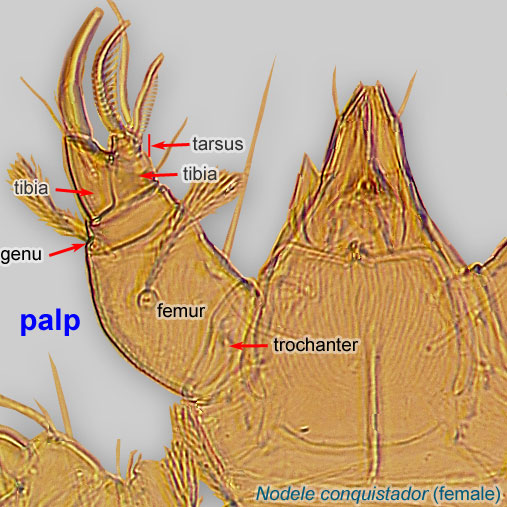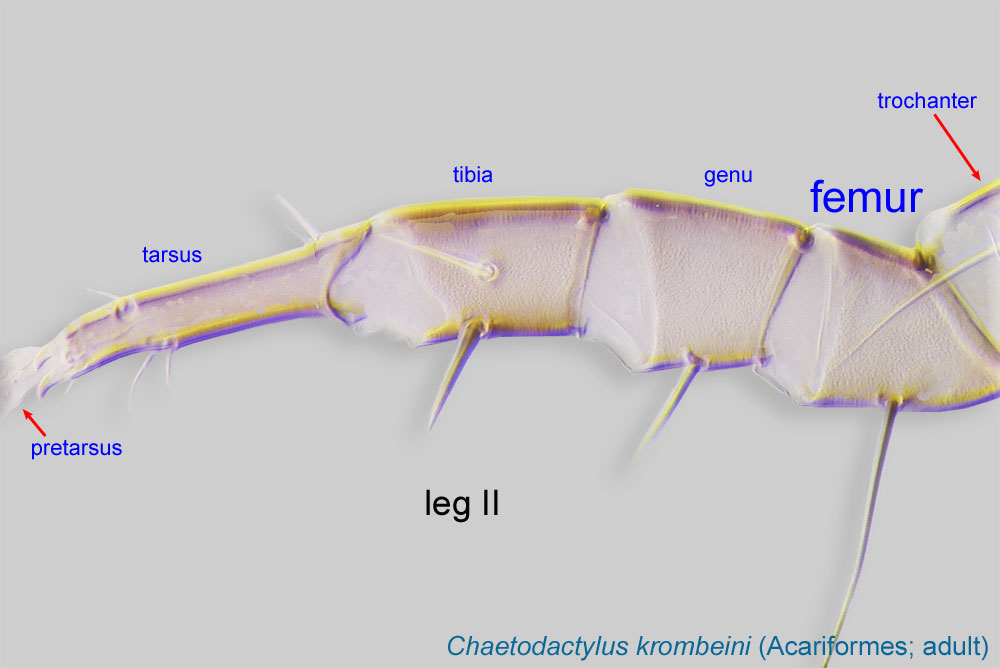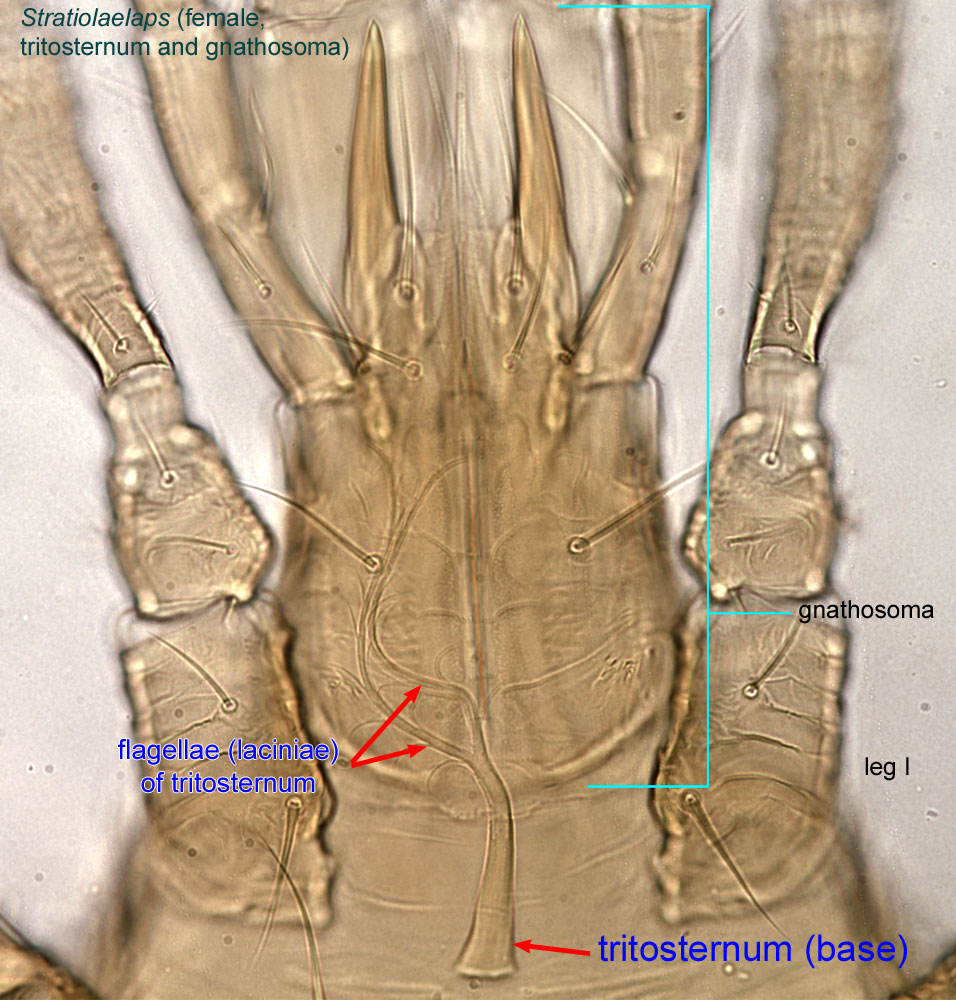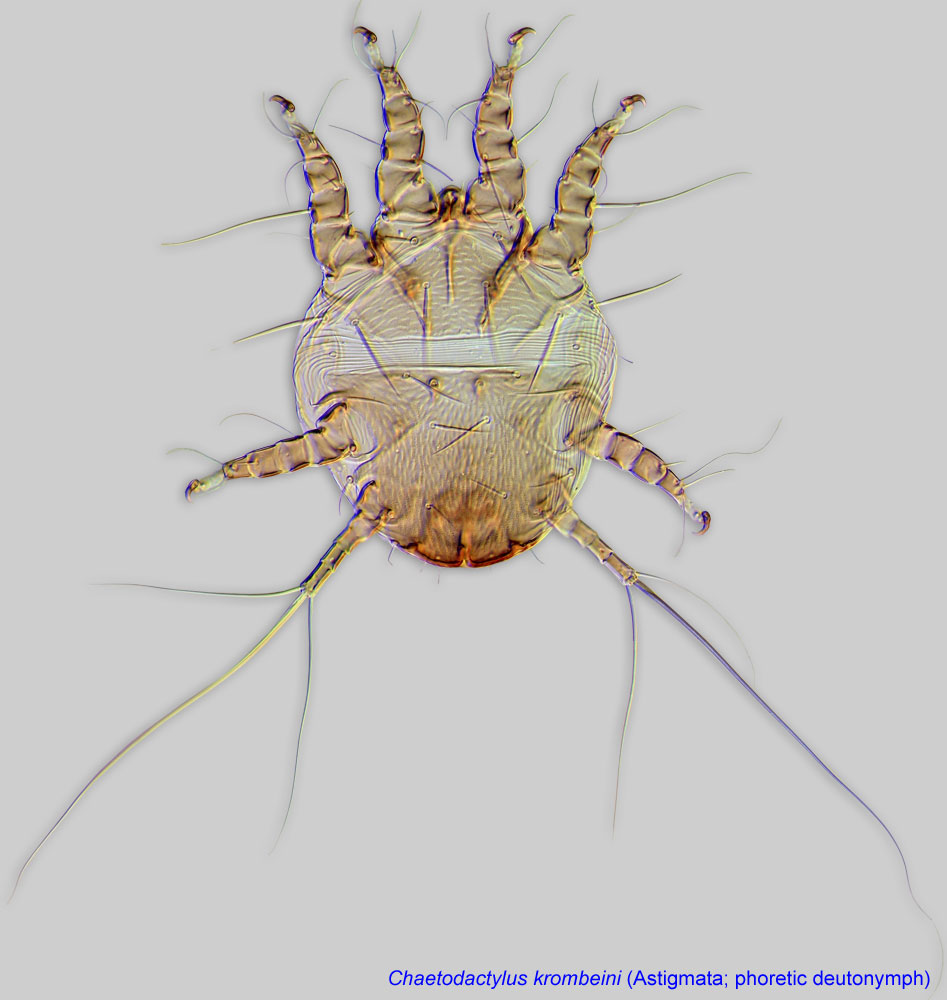neutral to beneficial; habitat generalist predator
Parasitus Latreille, 1795
Superorder Parasitiformes » Order Mesostigmata » Suborder Monogynaspida » Hyporder Parasitiae » Family Parasitidae » Genus Parasitus
Acarus coleoptratorum Linnaeus, 1758
Coleogamasus Tichomirov, 1969; Phorytocarpais Athias-Henriot, 1979 (some authors consider this genus as valid)
Female, male, deutonymphs: Opisthogastric regionopisthogastric region:
Ventral body behind legs IV. Also known as opisthogaster and ventral opisthosoma.
with fewer than 30 pairs of setae (Fig. 2). Setae al of palppalp:
Second (after chelicera) paired appendage of the gnathosoma. Has a sensory function, but may be variously modified for other functions (e.g., raptorial, attachment to host, or filtering).
 femurfemur:
femurfemur:
Leg or palp segment (also known as podomere or palpomere) between genu and trochanter. In ParasitIformes can be subdivided into telofemur and basifemur.
 bifid (Fig. 6) or serrate (not spatulate distally or filiform). Setae z5 of dorsal hexagon are markedly different in form from j5 and j6, usually stout and serrate (Fig. 3).
bifid (Fig. 6) or serrate (not spatulate distally or filiform). Setae z5 of dorsal hexagon are markedly different in form from j5 and j6, usually stout and serrate (Fig. 3).
Male: Tritosternumtritosternum:
In Mesostigmata, a biflagellate structure situated on the ventral side of the body, posterior to the gnathosoma and anterior to the sternal shield. Sometimes the flagellae (laciniae) are partially or completely fused.  of male absent or modified.
of male absent or modified.
A dichotomous key is available in Hyatt, 1980Hyatt, 1980:
Hyatt, K. H. 1980. Mites of the subfamily Parasitinae (Mesostigmata: Parasitidae) in the British Isles. Bulletin of the British Museum (Natural History) Zoology. 38: 237-378..
In Vulgarogamasus, setae of dorsal hexagon almost similar in form. Base of male tritosternumtritosternum:
In Mesostigmata, a biflagellate structure situated on the ventral side of the body, posterior to the gnathosoma and anterior to the sternal shield. Sometimes the flagellae (laciniae) are partially or completely fused.  never closely associated with genital orifice. In Parasitus, setae of dorsal hexagon different in form: setae z5 stout and pilose and j5 and j6 simplesimple:
never closely associated with genital orifice. In Parasitus, setae of dorsal hexagon different in form: setae z5 stout and pilose and j5 and j6 simplesimple:
Of claws or setae; not modified or not bi- or trifurcate at tip.
, and base of male tritosternumtritosternum:
In Mesostigmata, a biflagellate structure situated on the ventral side of the body, posterior to the gnathosoma and anterior to the sternal shield. Sometimes the flagellae (laciniae) are partially or completely fused.  closely associated with genital orifice. In Parasitellus, the opisthogastric regionopisthogastric region:
closely associated with genital orifice. In Parasitellus, the opisthogastric regionopisthogastric region:
Ventral body behind legs IV. Also known as opisthogaster and ventral opisthosoma.
has more than 40 setae (fewer than 30 pairs of setae in Parasitus and Vulgarogamasus).
Species associated with bees have been found in the Holarctic region (North America and Eurasia).
Generalist species have been found in nests of bumble bees (Bombus) and honey bees (Apis).
facultativefacultative:
can complete entire life cycle without bees or their close relative, wasps
Species of this genus are habitat generalists, living in manure, dung, compost, or other decaying organic substances. They feed on various animal prey, including rhabditid nematodes, mites, and sciarid and phorid fly larvae (Szafranek et al., 2013Szafranek et al., 2013:
Szafranek, P., M. Lewandowski amp; M. Kozak. 2013. Prey preference and life tables of the predatory mite Parasitus bituberosus (Acari: Parasitidae) when offered various prey combinations. Experimental and Applied Acarology. 61: 53-67.). Typically, mite deutonymphsdeutonymph:
Ontogenetic stage between protonymph and tritonymph (or adult, if tritonymph is absent). See <a href="index.cfm?pageID=1720">Life stages page</a> for more details. are phoreticphoretic:
are phoreticphoretic:
Pertaining to phoresy; using another organism (i.e., a host) for dispersal to new habitats. Phoresy can be distinguished from parasitism because feeding typically does not occur during phoresy.
on dung beetles (Hyatt, 1980Hyatt, 1980:
Hyatt, K. H. 1980. Mites of the subfamily Parasitinae (Mesostigmata: Parasitidae) in the British Isles. Bulletin of the British Museum (Natural History) Zoology. 38: 237-378.). Five named generalist species of Parasitus (Parasitus beta, P. coleoptratorum, P. consanguineus, P. fimetorum, and P. loricatus) have been found in bumble bee nests and beehives. This genus is unlikely to be a harmful parasite though, because it lacks adaptations to prey on bee larvae inside capped brood cells.